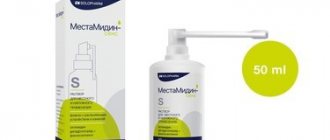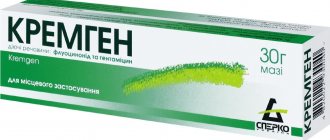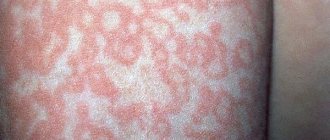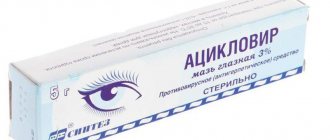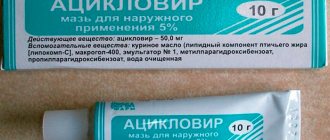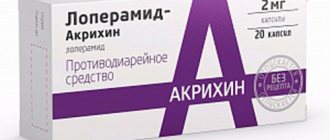pharmachologic effect
Antiviral agent for topical use.
The antiviral drug is a synthetic analogue of thymidine nucleoside. In infected cells containing viral thymidine kinase, phosphorylation occurs and is converted to acyclovir monophosphate. Under the influence of acyclovir guanylate cyclase, monophosphate is converted into diphosphate and, under the action of several cellular enzymes, into triphosphate. High selectivity of action and low toxicity to humans are due to the absence of the necessary enzyme for the formation of acyclovir triphosphate in intact cells of the macroorganism.
Acyclovir triphosphate, being integrated into the DNA synthesized by the virus, blocks the reproduction of the virus. The specificity and very high selectivity of action are also due to its predominant accumulation in cells affected by the herpes virus. Highly active against Herpes simplex virus types 1 and 2; the virus that causes chickenpox and herpes zoster (Varicella zoster); Epstein-Barr virus. Moderately active against cytomegaloviruses.
Analogs
In cases where Acyclovir does not help, you must consult a doctor to prescribe a substitute. Analogs of the pharmaceutical drug are: Arviron, Giporamin, Valtrex, Minaker, Trivorin, Viru-Merz, Herpferon, etc.
Read further:
Acyclovir eye ointment: instructions and indications for use, effectiveness, reviews and analogues
Acyclovir Hexal: instructions for use of cream and reviews
Acyclovir for herpes: ointment and tablets for effective treatment (tips and reviews)
Acyclovir Belupo cream for herpes: instructions for use, review and reviews
Acyclovir for barley on the eye: instructions and recommendations for use, effectiveness, analogues and reviews
Acyclovir Akrikhin ointment (review) from 38 rub.
Description
Antiviral drug. Good for treating herpes.
Overall
4.7
- Efficiency
- Price
- Safety
- Availability
Pros
- Price
- Efficiency
- Without smell
Cons
- Possible side effects
special instructions
To achieve the maximum therapeutic effect, it is necessary to use the drug as early as possible (at the first signs of the disease: burning, itching, tingling, feeling of tension and redness).
The ointment is not recommended to be applied to the mucous membranes of the mouth and eyes, because the development of severe local inflammation is possible.
When treating genital herpes, you should avoid sexual intercourse or use condoms, because the use of acyclovir does not prevent transmission of the virus to partners.
Instructions for use
In accordance with the recommendations presented in the annotation for the drug, the ointment composition is applied with clean hands (treated with an antiseptic), or sterile cotton balls are used for this purpose. Preliminarily affected and adjacent areas of the epidermis are carefully treated with Chlorhexadine in order to neutralize the risk of infection entering the wounds.
Aciclovir ointment is applied to the affected areas with a sterile cotton pad or clean hands. The ointment is applied only externally to the affected areas:
- 1-2 g of the medicinal composition is applied to the surface of the epidermis;
- the thick consistency is evenly distributed over the treated area;
- frequency of treatment – 4-5 times a day with an interval of 4 hours, excluding sleep.
Impact on pathogenic microflora begins as early as possible after infection. The duration of the course is 5 days, but no more than 10. If a crust has not formed on the surface of the blisters after 10 days, we recommend that you seek help from a doctor.
Indications for use
What is Acyclovir quinine ointment used for? – Most patients ask this question, since we are talking about a large family of antiviral drugs. Below is a list of diseases and pathologies for which the doctor prescribes liniment.
Aciclovir ointment helps to cope with any types of herpes
- Herpetiform rashes of a unilateral type on the surface of the epidermis, accompanied by severe painful sensations (herpes zoster).
- Infectious skin lesions caused by HSV activity (in 80% of patients, HSV type 2).
- Chicken pox.
- Herpes of the genital type.
You should first consult your doctor to rule out side effects.
Contraindications and side effects
The peculiarity of Acyclovir quinine ointment is that it is practically not absorbed through the skin, i.e. tissue absorption is minimal. Due to this property, the pharmaceutical product has virtually no contraindications. An exception is the patient’s individual intolerance to the active elements of the composition (both main and auxiliary), increased susceptibility to them.
During pregnancy, the use of Acyclovir quinine ointment is strictly prohibited. Use with caution and under medical supervision is allowed in the following patients:
- women during pregnancy;
- severe dehydration of the body;
- renal failure in chronic or acute form;
- breastfeeding a child (during lactation, local treatment in short courses is allowed).
It is important for these patients to be observed by a doctor throughout the entire period of therapy, as well as 3-4 days after the end of treatment.
Possible side effects:
- increasing itching;
- local burning at the treatment site;
- development of allergic dermatitis;
- intense peeling of the epithelium;
- inflammation of the mucous membranes of the eyes or mouth (if liniment gets into the corresponding areas).
The above reactions disappear after 4-6 hours and do not require contacting a medical facility.
Diclofenac Akrikhin
A non-hormonal drug with a pronounced anti-inflammatory effect is Diclofenac Akrikhin. The ointment is in wide demand due to its affordable price and high efficiency.
Release form and composition
The dosage form is produced in the form of a 1% white ointment with a yellow or gray tint, sometimes with pearlescent inclusions. The composition includes the main component diclofenac sodium, and auxiliary chemicals in the form of:
- dimethyl sulfoxide;
- macrogol;
- propylene glycol;
- succinic acid.
Properties and therapeutic actions
Diclofenac Akrikhin is a non-steroidal anti-inflammatory drug and exhibits analgesic properties. Therapeutic effects are achieved by inhibiting cyclooxygenase, inhibiting the synthesis of arachidonic acid and prostaglandins, which are involved in the mechanism of inflammation. When used topically, the active substance penetrates the tissue and accumulates in the synovial fluid of the joints, providing an analgesic effect and eliminating swelling. A small amount of the substance is absorbed into the systemic circulation.
Indications
The medicinal qualities of the main chemical compound determine the indications for the use of the ointment. The drug can be prescribed for:
- traumatic injuries of soft tissues and joints, bruises, sprains;
- rheumatic pathology with signs of damage to large and small joints;
- inflammatory processes of the muscular and nervous system;
- degenerative changes in bone tissue, which are accompanied by swelling and pain.
Contraindications
The ointment is contraindicated if the following symptoms occur:
- individual intolerance to the active substance;
- allergies in the form of an attack of bronchial asthma, urticaria, rhinitis while taking aspirin;
- pregnancy in the third trimester;
- severe damage to the liver and kidneys;
- lactation period;
- children under 6 years of age;
- violation of the integrity of the skin.
Side effects
"Acyclovir-acri" when used externally can cause adverse reactions and allergies. Most often patients experience:
- allergic dermatitis;
- burning;
- severe itching;
- peeling of the skin;
- inflammatory reactions upon contact with mucous membranes (for example, when the product gets into the mouth).
In some cases, a slight increase in temperature may occur. If the thermometer does not exceed 38 degrees, there is no need to take antipyretics or seek help from the hospital.
Sinaflan Akrikhin
Sinaflan Akrikhin is a remedy that helps against non-infectious inflammatory pathologies. The ointment is available and widely used in adults and children over 2 years of age.
Release form and composition
The drug is commercially available in a soft form, which contains the main component of fluocinolone acetonide in an amount of 0.025 grams per 100 grams of substance. Yellow ointment of uniform consistency for uniform application to the skin surface.
In addition to the active chemical compound, the composition is supplemented with:
- Vaseline;
- lanolin;
- liquid paraffin;
- propylene glycol.
Properties and therapeutic actions
Akrikhin Sinaflan has anti-inflammatory, anti-edematous, anti-allergic effects. The therapeutic effect is due to inhibition of the immune response and a decrease in the production of inflammatory mediators, which leads to a decrease in infiltration and exudation. A small amount of the substance penetrates the systemic circulation, after binding to plasma proteins, it is eliminated with the participation of the liver and kidneys.
Indications
Experts prescribe the drug for the following conditions:
- atopic dermatitis;
- limited neurodermatitis;
- eczema;
- skin itching;
- psoriasis;
- dermatitis, which is accompanied by dry skin.
Contraindications
Contraindications to the use of ointment are:
- inflammatory processes of microbial, fungal or viral etiology;
- manifestation of diaper dermatitis;
- acne;
- pathology of the digestive tract with manifestations of erosive and ulcerative gastritis;
- skin neoplasms;
- children under 2 years old.
Clotrimazole Akrikhin
Clotrimazole Akrikhin is an external agent with an antifungal effect. The ointment is used to treat mycoses of the skin and mucous membranes.
Release form and composition
The drug is produced in the form of a soft, white form with a characteristic odor. The main chemical element is clotrimazole, which makes up 1% of the composition. Adjuvants are presented:
- propylene glycol;
- nipagin;
- succinic acid;
- sodium benzoate;
- emulsion wax;
- castor oil;
- methylcellulose;
- monoglycerides;
- purified water.
Properties and therapeutic actions
The component of the same name has a fungistatic and fungicidal effect by blocking the synthesis of the enzyme ergosterol in cells, which prevents the growth and reproduction of fungal flora. The imidazole derivative is effective against dermatophytes, molds and yeasts. When applied topically, the drug does not have a systemic effect. Penetrates deeply into the epidermis and skin appendages, reaching maximum concentration in a short period of time.
Indications
Clotrimazole Akrikhin is prescribed for the following pathological changes:
- mycoses of the feet and nails caused by dermatophytes, including fungi of the genus Candida;
- fungal diseases associated with bacterial infection, as part of complex therapy;
- pityriasis versicolor and versicolor;
- erythrasma.
Contraindications
The ointment is not recommended to be applied if the following conditions occur:
- idiosyncrasy to the main component;
- bearing a fetus in the first three months of pregnancy;
- children's age up to 24 months.
In rare cases, while using the drug, the following symptoms are observed:
- the appearance of an allergic rash, itching;
- local reactions in the form of irritation, hyperemia, peeling, paresthesia.
Contraindications and harm
The drug should not be used by patients who have been diagnosed with hypersensitivity to the active ingredient. Other contraindications for Acyclovir ointment:
- hypersensitivity to valacyclovir;
- allergic reactions to the auxiliary components of the product.
Particular caution should be exercised in case of renal failure, dehydration and persons under 18 years of age.
Like most medicines, Acyclovir may have unwanted effects. Infrequently, temporary burning or tingling occurs in the treated areas of the skin, dryness, peeling, and itching.
Occasionally, redness and a hypersensitivity reaction in the form of contact dermatitis occur. Such properties are especially characteristic of propylene glycol, E477.
Recommendations for special categories of patients
Acyclovir ointment for children is used for the same indications as for adults. Before starting treatment, consultation with a pediatrician is required. It is especially important for minors and elderly people to follow the dosage and not exceed the frequency and duration of use of the medicine.
Acyclovir cream or ointment is not contraindicated during pregnancy. The systemic effect of these dosage forms is insignificant.
However, the drug is prescribed with caution during pregnancy. Acyclovir is indicated when the therapeutic benefit is greater than the risk of contraindications.
If a nursing woman uses an external remedy, the baby receives a negligible dose of the medicine through breast milk.
When Acyclovir ointment is prescribed during breastfeeding, each situation is considered individually. Specialists will decide whether it is possible to continue breastfeeding during treatment.
Acyclovir-Acri
Active substance:
Acyclovir*
Pharmgroup:
Antiviral (except HIV) drugs
Average price in pharmacies
| Name | Manufacturer | average price |
| Acyclovir-acriquin 0.2 n20 tablet | AKRIKHIN | 55.00 |
| Acyclovir-acriquin 0.4 n20 tablet | AKRIKHIN | 199.00 |
| Acyclovir-acriquin 5% 10.0 ointment for external use approx. tube/ | AKRIKHIN | 56.00 |
| Acyclovir-acrikhin 5% 5.0 ointment for external application/tube/ | AKRIKHIN | 32.99 |
Analogs for the active substance:Acigerpin Acyclovir Acyclovir Belupo Acyclovir HEXAL Acyclovir Stada International Acyclovir forte Acyclovir-AKOS Acyclovir-Ferein Acyclostad Vero-Acyclovir Vivorax Virolex Gervirax Gerpevir Herperax Herpesin Zovirax Lisavir Medovir Provirsan Supraviran Cyclovax Cyclovir Cycloviral SEDICO Citivir | Application area:Banal recurrent genital herpes Secondary genital herpes Severe immunodeficiency Genital herpes virus infection Genital herpetic infections Genital herpes Herpes genitals Herpes genital Herpes of the genital lips Genital herpes Herpetic lesions of the mucous membranes of the genitourinary organs Herpetic lesions of the genitals Immune deficiency Immunodeficiency Immunodeficiency diseases Immunodeficiency states due to surgery Immunocorrection for cancer Immunomodulation Infections in immunocompromised patients Correction of immune deficiency Correction of immunodeficiency conditions Correction of weakened immunity Correction of weakened immunity in immunodeficiency states Immunity disorder Impaired immune status Immune system disorder Primary immunodeficiency conditions Primary genital herpes Primary genital herpes Primary immunodeficiency Pneumonia in immunodeficiency states Maintaining immunity Decreased defenses Decreased immunity Decreased immunity due to colds and infectious diseases Decreased immune status Reduced resistance to infectious diseases Reduced resistance to infectious and colds Reduced body resistance Reduced immunity Predisposition to colds Acquired immunodeficiency Herpes simplex extragenital and genital localization Radiation immunodeficiency Development of immunodeficiency Recurrent genital herpes Recurrent genital herpes Immune dysfunction syndrome Immunodeficiency syndrome Primary immunodeficiency syndrome Decreased body defenses Decreased immunity Decreased immune defense of the body Decreased local immunity Decreased overall body resistance Decreased levels of cellular immunity Decreased resistance to infections in children Decreased body resistance Reduced body resistance Reduced immunity Immunodeficiency state Stimulation of nonspecific immune processes Severe secondary selective immunodeficiency Immune suppression Herpes simplex genitalis |


